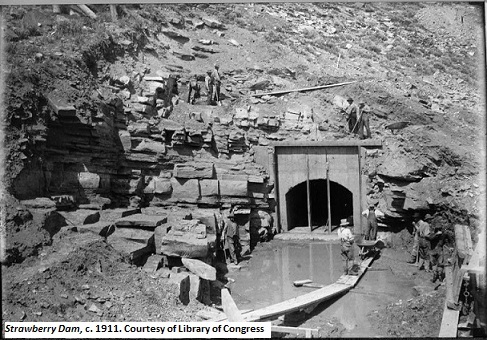Dublin Core
Title
Description
A federal project diverted water promised to the Ute Tribe into southern Utah County. This water grab harmed Ute claims to land in the Uintah Basin.
In 1905 the federal government authorized the Strawberry Valley Project. Designed to divert water from the upper Strawberry River into the Spanish Fork River through a tunnel underneath the Wasatch Divide, the project was meant to benefit the farms of southern Utah County. The extra water from this project would be a big win for white farmers, but the plan promised to be a major defeat for the Ute Indians of the Uintah Basin. They stood to lose not just the use of a good part of the water that flowed across the western edge of their reservation, but also a lot of their best land.
Since 1865, when the treaty was signed that required all Utes to give up their traditional tribal lands and move to a new reservation in the Uintah Basin, white ranchers and farmers consistently broke the pact by grazing their livestock on reservation land and by building illegal canals to siphon off Ute water for their own farms. They argued that the Utes were not using the land and water, so why couldn’t they? Within a matter of years, state and federal lawmakers had successfully shifted the Utes’ water and land rights to the white settlers.
Around 1900, another plan to grab more Ute resources was hatched, this time by a state senator from Spanish Fork named Henry Gardner. Gardner was passing through the Strawberry Valley when he came up with the idea to build a reservoir there and funnel its water across the Wasatch Mountains to Utah County. It took only 5 years for the Secretary of the Interior to authorize the Strawberry Valley Project, and by 1906, the U.S. Bureau of Reclamation was digging a tunnel through the mountains. Two years later, construction began on the dam that eventually created Strawberry Reservoir.
The negative impact of the Strawberry Valley Project on the Utes of the Uintah Basin was great. Not only were they never consulted about the land and water grab, but their title to the land was permanently extinguished and given to non-Indians. Not surprisingly, the project also opened up the Uintah Reservation to further incursions from white settlers and mining companies in the years that followed.
Creator
Source
Image: Strawberry Dam. Upstream portal of sluicing tunnel, c. 1911. View to east. Payson, Utah County, UT. Courtesy of Library of Congress.
_______________
See Kathryn L. MacKay, “The Strawberry Valley Reclamation Project and the Opening of the Uintah Indian Reservation,” in John S. McCormick and John R. Sillito, ed., A World We Thought We Knew: Readings in Utah History (Salt Lake City: University of Utah Press, 1995); and Howard A. Christy, “Open Hand and Mailed Fist: Mormon-Indian Relations in Utah, 1847-52,” Utah Historical Quarterly 46 (Summer 1978): 216-235. Also see Virginia McConnell Simmons, The Ute Indians of Utah, Colorado, and New Mexico (Boulder: University Press of Colorado, 2000), 226-227, and David Rich Lewis’s entry on the Northern Utes in the online Utah History Encyclopedia. Data on the Strawberry Valley Project can also be found at the U. S. Bureau of Reclamation website.

